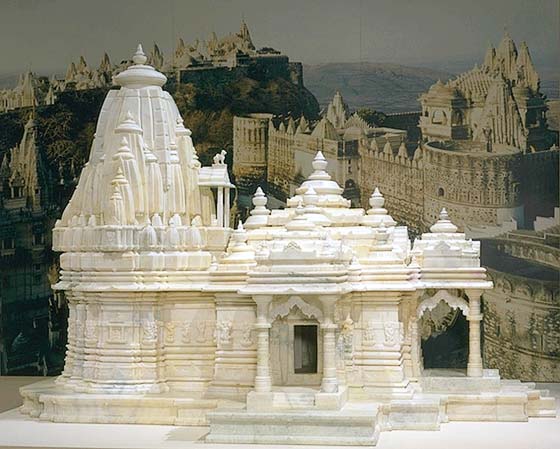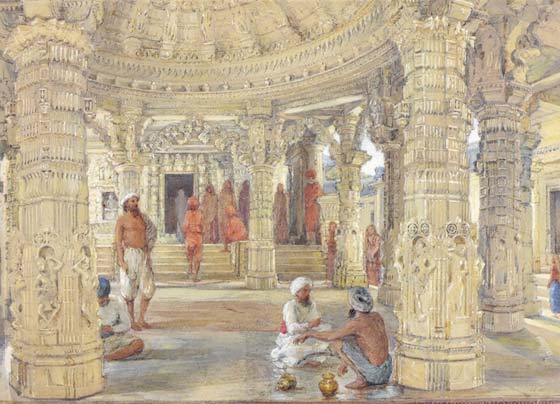Jain religious monuments are among the oldest and most ornate edifices erected in India. The Jain community was responsible for commissioning some of India's most lavish temples, both rock-cut and free-standing. The most famous are the spectacular white marble temples at Mount Abu.
The white marble model pictured here is a small-scale replica of a medieval Jain temple in Gujarat. It replicates in its 200 parts the architectural elements of a full-scale temple. It was carved at workshops in Ahmedabad, Gujarat, under the direction of the traditional temple architect Shree M. P. Trivedi.
 |
Model of a Jain temple (in situ in The Peaceful Liberators exhibition, V&A, 1995-1996), Shree M.P. Trivedi, Gujarat, Western India. Late 20th century. Reproduced with permission of the Oshwal Association of the UK. |
Jain religious monuments are among the oldest and most ornate edifices erected in India. In the Kushan period (1st-3rd centuries) some of the largest and finest Jain stupas were built at Mathura, the great commercial and artistic centre of northern India.
A number of surviving architectural segments and sculptural images, most carved from Mathura's distinctive mottled red sandstone, once adorned the region's temples and stupas.
In later centuries the Jain community was responsible for commissioning some of India's most lavish temples, both rock-cut and free-standing. The most famous of all Jain monuments are the spectacular white marble temples at Mount Abu, a pilgrimage site in southern Rajasthan.
 |
William Carpenter, Interior of the Domed Entrance to the main Jain Temple at Dilwara on Mount Abu, Rajasthan, western India 1851, Pencil and watercolour on paper, Museum no. IS.166-1881. |
Other sacred mountain sites graced with imposing temples include Ranakpur in Rajasthan, Girnar and Satrunjaya (near Palitana) in Gujarat, Sammeda in Bihar, Sravana Belgola in Karnataka and Ashtapada in the Himalayas. These architectural complexes represent the epitome of the Jain medieval temple tradition. Often placed in relatively unadorned enclosures, these temples are encrusted with sculpture, dazzling the worshipper with their wealth of imagery and sophisticated carving.
Although at Palitana the original temples were ruined by invaders in the 14th and 15th centuries, some fragments survive.
